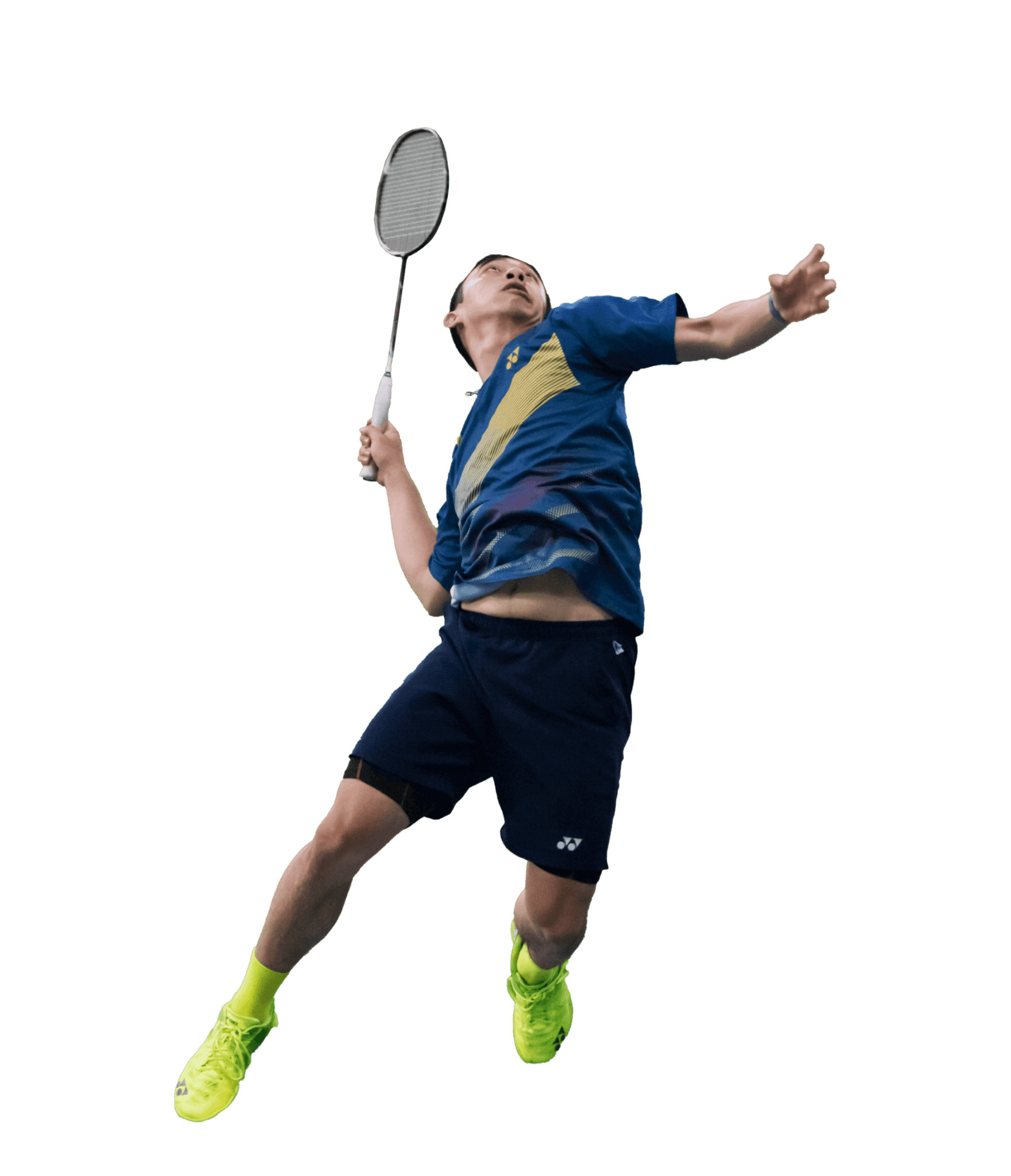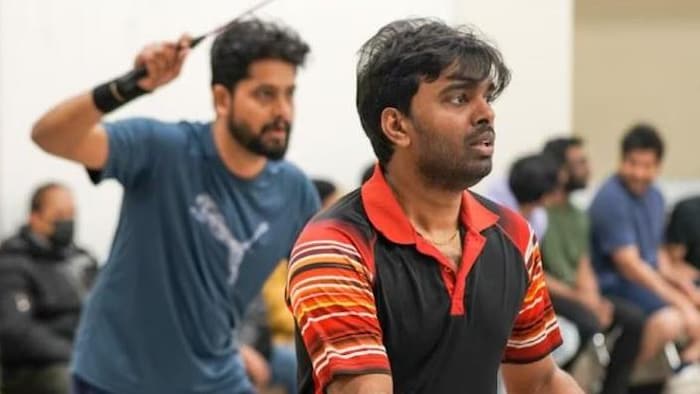The fundamentals are the most important aspect of any sport, especially badminton. The fundamentals of badminton include:
- Badminton footwork…
- Consistent shots (drive, clears, lifts, drops, and smash)…
- … and, of course – the grip.
If you don’t master the grip early on in badminton, not only will your shots not be as consistent and powerful – you’ll also have to spend months re-learning the grip at a later date.
Same as I needed to. After the first 3 years of my 18-year badminton career, I changed coaches. And the second coach had me re-learn all the badminton basics (including the grip).
Not fun! But definitely worth it.
That’s why, in this post, you’ll discover the 4 different types of grips in badminton and how to properly perform them – so you don’t have to go through the same re-learning process as I did.
As a quick overview:
| # |
Grip Type |
Description |
Steps |
| 1 |
Forehand Grip |
Basic grip for shots on the forehand side. Essential for generating power and flexibility. |
- Turn the racket so the head is at 90 degrees to the floor.
- Grab the racket as if performing a handshake.
|
| 2 |
Backhand Grip |
Grip used for shots on the non-dominant side, giving more leverage with the thumb. |
- Turn the racket so the head is parallel to the floor.
- Place your thumb on the flat side of the grip.
|
| 3 |
Bevel Grip |
Used for shots where the shuttle is behind you, improving control and power. |
- Perform the backhand grip.
- Place your thumb on the beveled corner instead of the flat side.
|
| 4 |
Panhandle Grip |
Used for push and kill shots at the net, focusing on wrist movement for quick shots. |
- Hold the racket parallel to the net.
- Place your thumb as you would when holding a frying pan.
|
Let’s dive right in:
forehand grip” width=”834″ height=”534″/>
1. Badminton Forehand Grip
The forehand grip is the most basic grip in badminton and the grip that all players should learn first.
You can do the forehand grip in 2 simple steps:
- Turn the racket so the racket head is at 90 degrees to the floor (NOT parallel).
- Grab the racket as if you were to perform a handshake.
Your pointer finger will be leveraged on top to give your wrist more flexibility and more power. It will also allow you to snap your wrist to generate power properly.
For a video demonstration: https://www.youtube.com/watch?v=kMpaTqK871Y
This grip should be used for any shot on your forehand side. This is extremely simple to practice at home, so when you get the chance, ensure you have the proper forehand grip.
2. Badminton Backhand Grip
The backhand grip is used when any shot is played to your backhand side or non-dominant side.
Rather than twisting your body and trying to hit another forehand shot, you should simply switch your grip to the backhand grip and hit that way instead. It’s more efficient and faster this way, right?
Similar to the forehand grip, you too can do the backhand grip in 2 simple steps:
- Turn the racket so the racket head is parallel to the floor.
- Place your thumb on the flat side of the racket grip, similar to how you might hold a frying pan.
Remember: Forehand grip – handshake. Backhand grip – frying pan.
For a video demonstration: https://www.youtube.com/watch?v=CwaYQFYo2B4
The backhand grip is super effective, as the thumb on the flat side of the racket gives you more leverage.
This allows you to generate more power by pressing down on the racket grip and ‘pushing through’ the racket.
You can push down on the other side of the racket handle with your thumb – and you generate more force on the other side. Almost like pressing a button. READ FULL STORY HERE>>>CLICK HERE TO CONTINUE READING>>>

3. Badminton Bevel Grip (Or ‘Corner Grip’)
The bevel or ‘corner grip’ is a grip very similar to the backhand grip. You, too, use it when the shuttle flies toward your non-dominant side.
The only difference is that you use the bevel grip when the shuttle flies over your head!
- So shorter shots that land in front of you: Backhand grip.
- Longer shots that require you to turn your body (back facing towards your opponent): Bevel grip.
It’s that simple, really, but most players don’t use it!
In fact, I didn’t know how to use this grip until 8 years after I started playing. I always thought I had a ‘weak backhand’, when the reality was that I simply used the wrong grip!
How to turn your backhand grip into a bevel grip in 2 simple steps:
- Do the backhand grip (see instructions above)
- Place your thumb not on the flat side, but a little bit to the right on the, also called ‘bevel’
For a video demonstration: https://www.youtube.com/shorts/AIcXtXUGX2g
Similar to the backhand grip, your thumb will be generating most of the power in this shot. But because the thumb is placed at a slightly different position, it allows you to use more power when your back is facing the opponent.

4. Badminton Panhandle Grip
The last grip to learn is the panhandle grip. This grip is similar to the forehand grip.
In fact, most beginners natural instinct is to use the panhandle grip for all shots, so you might actually already know how to do it – without realizing it!
- While the forehand grip is used for most ‘general’ shots…
- … the panhandle grip is used to hit a push or a kill shot in the front court.
There are 2 simple differences to the forehand grip:
- Instead of being ‘slanted’ (as in the forehand), your badminton racket should be directly parallel to the net. The reason is that when you hit a kill shot, your badminton racket is typically higher than the net, right?
- An additional difference is the thumb position. Similar to the backhand, the thumb is positioned like a frying pan – instead of like a ‘V’.
For a video demonstration: https://www.youtube.com/watch?v=1K5wrw35Ya4
Remember that the power in the panhandle grip is generated from your full wrist pushing down on the shuttle, making it easy to hit pushes and net kills!

Frequently Answered Questions About The 4 Badminton Racket Grips
I’ve tried to make the previous blog post as comprehensive as possible. However, there might still be open questions you have about the specifics of the 4 badminton grips, or overall questions about how to hold the badminton racquets correctly.
Here are answers to some of the questions you might still have lingering top of mind:
How to grip a badminton racket?
There are 4 different ways to grip a badminton racket:
- Forehand grip
- Backhand grip
- Bevel grip
- Panhandle grip
The grip method depends on the shots you’re aiming to hit – or the shots your opponent hits you with.
The right grip method significantly increases the power you can generate with every shot.
How to change forehand grip to backhand grip in badminton?
You can transition from a forehand grip to a backhand grip in 3 simple steps:
- Loosen the grip from your fingers while maintaining a secure hold on the racket.
- Rotate the racket by turning your wrist to the left slightly. This turns the forehand position into a backhand position.
- Place the thumb against the back of the handle for support (on the other side where the shuttlecock hits).
With enough practice, this simple switch should need you less than half of a second!

 SPORTS5 months ago
SPORTS5 months ago
 METRO4 months ago
METRO4 months ago
 METRO4 months ago
METRO4 months ago
 METRO3 months ago
METRO3 months ago
 SPORTS5 months ago
SPORTS5 months ago
 METRO4 months ago
METRO4 months ago
 METRO4 months ago
METRO4 months ago
 METRO3 months ago
METRO3 months ago






